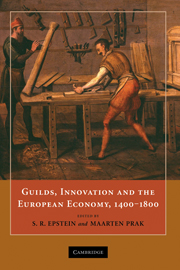Book contents
- Frontmatter
- Contents
- List of Contributors
- Acknowledgments
- Introduction: Guilds, Innovation, and the European Economy, 1400–1800
- 1 Craft Guilds, the Theory of the Firm, and Early Modern Proto-industry
- 2 Craft Guilds, Apprenticeship, and Technological Change in Pre-industrial Europe
- 3 Subcontracting in Guild-based Export Trades, Thirteenth–Eighteenth Centuries
- 4 Circulation of Skilled Labour in Late Medieval and Early Modern Central Europe
- 5 Painters, Guilds, and the Art Market during the Dutch Golden Age
- 6 Craft Guilds and Technological Change: The Engine Loom in the European Silk Ribbon Industry in the Seventeenth and Eighteenth Centuries
- 7 Guilds, Technology, and Economic Change in Early Modern Venice
- 8 Inventing in a World of Guilds: Silk Fabrics in Eighteenth-century Lyon
- 9 ‘Not to Hurt of Trade’: Guilds and Innovation in Horology and Precision Instrument Making
- 10 Reaching beyond the City Wall: London Guilds and National Regulation, 1500–1700
- 11 Guilds in Decline? London Livery Companies and the Rise of a Liberal Economy, 1600–1800
- Index
8 - Inventing in a World of Guilds: Silk Fabrics in Eighteenth-century Lyon
Published online by Cambridge University Press: 24 June 2009
- Frontmatter
- Contents
- List of Contributors
- Acknowledgments
- Introduction: Guilds, Innovation, and the European Economy, 1400–1800
- 1 Craft Guilds, the Theory of the Firm, and Early Modern Proto-industry
- 2 Craft Guilds, Apprenticeship, and Technological Change in Pre-industrial Europe
- 3 Subcontracting in Guild-based Export Trades, Thirteenth–Eighteenth Centuries
- 4 Circulation of Skilled Labour in Late Medieval and Early Modern Central Europe
- 5 Painters, Guilds, and the Art Market during the Dutch Golden Age
- 6 Craft Guilds and Technological Change: The Engine Loom in the European Silk Ribbon Industry in the Seventeenth and Eighteenth Centuries
- 7 Guilds, Technology, and Economic Change in Early Modern Venice
- 8 Inventing in a World of Guilds: Silk Fabrics in Eighteenth-century Lyon
- 9 ‘Not to Hurt of Trade’: Guilds and Innovation in Horology and Precision Instrument Making
- 10 Reaching beyond the City Wall: London Guilds and National Regulation, 1500–1700
- 11 Guilds in Decline? London Livery Companies and the Rise of a Liberal Economy, 1600–1800
- Index
Summary
This chapter examines the production of silk brocades in Lyon in the eighteenth century through the technical possibilities and skills that underpinned inventiveness, the social status of inventive artisans, and the policy of innovation that the powerful silk guild known as the Grande Fabrique developed in tune with the municipality. Thanks to Lesley E. Miller and Carlo Poni, we know about the practices and the context of artistic creation in Lyon, especially the part played by design. The success of the Lyon silk fabrics relied on design creativity and on the management of stocks of patterns owned by local firms. Their protection, application, and fraudulent circulation were the basis of the new Lyon fashions launched yearly across Europe. The utility of design was based upon technical ingenuity. Inventing a new fabric relied on a combination of new patterns as well as new devices and commercial projects, calculations, and plans. No refined patterns could have been realised without the multiplication of warp threads and of numerous tiny shuttles for weft threads, new devices for quickly changing patterns on looms, and new stitches giving the illusion of relief, shades, and half-tones in portraits. New flowered silks were at the heart of a web combining work on shapes, materials, processes, and projects.
- Type
- Chapter
- Information
- Guilds, Innovation and the European Economy, 1400–1800 , pp. 232 - 263Publisher: Cambridge University PressPrint publication year: 2008
- 5
- Cited by



